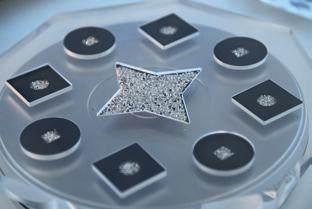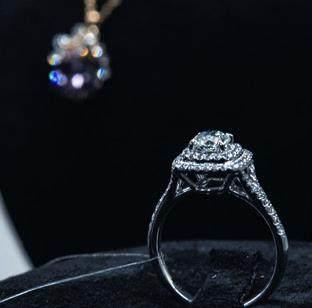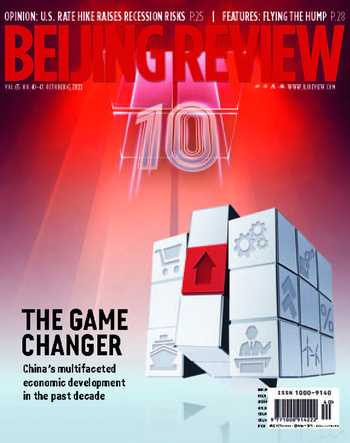A Brilliant Business
By Ji Jing


A trending hashtag “Henan Province has become the largest producer of cultured diamonds in the world” has become popular on multiple social media platforms recently.
In 2021, global lab-grown diamond output reached 9 million karats, of which 4 million was produced in Zhecheng, a county in Henan.
As the name suggests, lab-grown diamonds are diamonds that are produced in a lab using the same extreme forces—temperature and pressure—that form naturally created diamonds. There is no chemical, optical, or physical difference between a lab-grown diamond and a natural one.
Lab-grown diamonds are manufactured using either the high pressure and high temperature(HPHT) process or the chemical vapor deposition(CVD) process; both use a tiny “seed” diamond.
The CVD method places a tiny diamond seed inside a chamber that can be taken to extremely high temperature and pressure. Carbon-rich gases are pumped into the chamber, with the extreme heat breaking the molecular bonds in the gases, releasing the carbon, which then attaches directly onto the seed diamond, the surface of which provides a template for the arrangement of the carbon atoms into new layers of diamond.
The HPHT method places a tiny diamond seed into the center of high-purity source of solid carbon, which is then heated and compressed. The resulting molten carbon then forms new layers of diamond on the seed in a similar manner to the vaporized carbon atoms of the CVD method.
American corporation General Electric created the first batch of cultured diamonds in 1954.
Strong technological foundations
Why has Henan become the worlds factory for lab-grown diamonds?
The province in central China has solid technological foundations for producing artificial diamonds. In the 1950s, Zhengzhou, capital of Henan, was assigned by the Central Government to develop the abrasive industry. Zhengzhou Research Institute for Abrasive and Grinding (ZZSM), established in 1958, was a leader of the industry.
As one of the hardest materials in nature, diamond is an important industrial material in addition to being prized as jewelry.
In the 1950s, China relied on imports of diamonds for industrial use. To shed the reliance on imports, the country launched a research project to develop artificial diamonds. In 1963, the ZZSM developed a press, a machine for creating diamonds. In December that same year, China succeeded in producing its first created diamond using the machine.
In 1965, the institute developed a new press which has production efficiency 10 times higher than the one developed in 1963, which made it possible to carry out the industrialized production of artificial diamonds.
In the 1980s, Feng Jinzhang, an engineer with the ZZSM returned to his hometown, the aforementioned Zhecheng, to start a diamond factory. The factory produced micron diamond powder, an ideal material for griding and polishing super-hard materials such as optical glass.
Later, more micron diamond powder factories were established in the county, making it a major producer of the material by 2000 and forming the foundation for the artificial diamond industry today.
Since 2009, a batch of factories have been introduced to the county, establishing a complete artificial diamond industrial chain.

In September last year, the countys Henan Liliang Diamond Co. Ltd. went public on the Shenzhen Stock Exchange and in July this year, the countys Huifeng Diamond Co. Ltd. went public on the Beijing Stock Exchange.
In addition to companies in Zhecheng, the ZZSM also cooperates with artificial diamond companies in other parts of Henan, such as Zhongnan Diamond Co. Ltd. in Nanyang.
Market prospects
Cultured diamonds are gaining more recognition globally. In 2018, the U.S. Federal Trade Commission issued a new guideline saying lab-grown diamonds are diamonds too and now steers clear of the words “synthetic” and“lab-grown.”
That same year, technological advances led to retail prices of artificial diamonds being greatly reduced. Now, the cost of cultivating 1 karat of diamond is around 3,000 yuan ($419.4), 10 times less than the cost in 2018.
According to Brilliant Under Pressure: The Global Diamond Industry 2020–21 report released last February by American management consulting firm Bain & Company in collaboration with the Antwerp World Diamond Center, the retail price difference between natural and synthetic stones has widened yet again. The retail price of a 1-karat lab-created diamond fell to only 35 percent of an equivalent mined diamond. In 2019 and 2018, this figure was 50 percent, and in 2017 it was 65 percent.
Many foreign companies have realized the market potential and come up with their own artificial diamond brands. For instance, in 2016, Swarovski came up with the Diama lab-grown diamond brand and in 2018, natural diamond giant De Beers launched artificial diamond brand Lightbox Jewelry.

Domestic jewelry companies have also delved into the field of artificial diamonds in recent years. Shanghai Yuyuan Tourist Mart Co. Ltd., the parent company of Shanghai Laomiao Gold Co. Ltd., launched its artificial diamond brand Lusant in August last year and jewelry company Mclon, based in Hangzhou, Zhejiang Province, established artificial diamond brand Own Shine this year.
The lab-grown diamond industry is a lucrative one. According to Sinolink Securities, the lab created diamond jewelry industry has a gross profit rate of 50 to 60 percent and a net profit rate of 10 to 20 percent.
The upstream industry also has high profits. According to the half-year report of Liliang Diamond released in August, its lab-grown diamond has a gross profit rate of 83 percent.
The profitability of the lab-grown diamond jewelry industry has also attracted investorsattention. At the end of last year, manmade diamond jewelry brand Light Mark received an investment of 130 million yuan ($18.2 million).
According to Guotai Junan Securities, the U.S. accounts for 80 percent of the global created diamond consumer market while China is still at the stage of consumer education.
Yang Fan, Deputy General Manager of Divine Diamond Co. Ltd., told the Beijing Business Today newspaper that the development of the artificial diamond market relies on continuous consumer education, which needs to be supported by strong networks of offline outlets. Solely relying on promotions of new brands cannot drive the development of the market.
Wang Dongwei, Chairman of Zhongtai Capital Investment Management Co. Ltd., told the Beijing Business Today that cultured diamonds provide more choices for consumers on a limited budget. However, the market will become more transparent and see fiercer competition. Therefore, the gross profit rate will go down gradually but the sales volume might register continuous increase. BR

